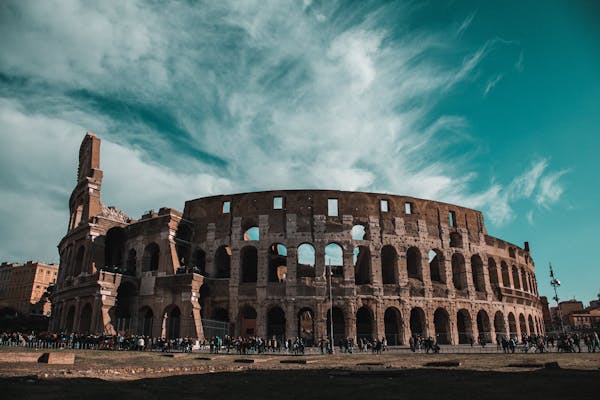The Colosseum isn’t just a landmark; it’s a testament to Rome’s architectural brilliance and turbulent history. This guide unveils essential tips for exploring this ancient amphitheater, from securing tickets to uncovering hidden gems within its walls. Prepare to step back in time and immerse yourself in the stories etched into its stone. Get ready to make the most of your visit to this iconic symbol of Rome’s grandeur.
Colosseum Overview and Historical Significance
The Colosseum, also known as the Flavian Amphitheater, is an icon of ancient Rome’s architectural brilliance and rich cultural history. Constructed between AD 70 and 80 under the direction of Emperor Vespasian and completed by his heir Titus, the Colosseum was intended as a monumental gift to the Roman people. With its primary purpose as an arena, it could host up to 50,000 spectators, sometimes swelling to 65,000, offering a stage for gladiatorial combat, exotic animal hunts, and grand public spectacles. Interestingly, its construction was financed by spoils from the conquest of Jerusalem, symbolizing Rome’s vast influence and military prowess. For further details on planning your visit to this landmark, https://visit-colosseum-rome.com/ provides valuable resources.
Topic to read : Unforgettable Harry Potter adventures you can have in London
The Colosseum’s design is a masterpiece of engineering, showcasing a combination of Doric, Ionic, and Corinthian columns across its three visible levels. It spans an impressive 620 by 513 feet, with 80 arched entrances ensuring efficient crowd management—a testament to Roman ingenuity. Its tiered seating system reflected the rigid social hierarchy of ancient Rome, with the best views reserved for elites and upper echelons, while commoners occupied the higher tiers. Beneath the arena floor lay an intricate network of underground chambers and tunnels, known as the hypogeum, where gladiators and wild animals were prepared for the day’s events, providing a glimpse into the mechanics of these dramatic performances.
As a cultural hub in ancient Rome, the Colosseum was central to civic life, reinforcing Rome’s grandeur and the emperor’s generosity toward the populace. The structure hosted events ranging from athletic contests to mock sea battles, providing a unique amalgamation of entertainment, propaganda, and Roman identity. Despite facing devastation from earthquakes, neglect, and repurposing over the centuries, the Colosseum endures as a symbol of resilience and historical significance.
Have you seen this : Explore london”s premier locations for an unforgettable authentic english tea ceremony!
Today, visiting the Colosseum takes travelers on a journey through time, exploring its architectural marvels and the layers of history that define it. Whether you’re marveling at the towering arches, walking through the hypogeum’s remnants, or simply standing in awe of its scale, the Colosseum continues to captivate enthusiasts of history and archaeology alike.
Visiting the Colosseum: What You Need to Know
Ticket Options and Pricing
When planning your visit to the Colosseum, understanding the ticketing system is key. Standard entry tickets typically include access to the Colosseum, the Roman Forum, and Palatine Hill. Prices for these standard tickets usually hover around 18 euros for adults, with discounted rates for reduced categories such as EU citizens between 18–25 years old and free entry for children under 18. Tickets are valid for two consecutive days, allowing ample time to explore these historic sites.
For a more enhanced experience, guided tours or skip-the-line options are highly recommended. These options often grant access to restricted areas, such as the Colosseum’s underground chambers and arena floor, which aren’t available to standard ticket holders. Prices for guided tours start at approximately 35 euros, depending on the inclusions. Travelers are encouraged to purchase tickets online well in advance to avoid long queues and ensure availability, especially during peak tourist seasons.
For those on a budget, the first Sunday of every month offers free entry to the Colosseum and other state-run monuments in Rome. However, expect larger crowds during these days as they attract both tourists and locals.
Opening Hours and Entry Process
The Colosseum operates on a seasonal schedule. Generally, it opens at 9:00 AM year-round, but closing times vary depending on the time of year. During the winter months, the Colosseum closes at 4:30 PM, while summer days extend the closing time to 7:15 PM. Entry is permitted up to an hour before closing, so be timely to fully enjoy your visit. Keep in mind that the Colosseum is closed on specific holidays, such as Christmas Day and New Year’s Day.
To streamline the entry process, online reservations are highly advisable. Digital tickets often come with a designated time slot, requiring punctual arrival to maintain your slot and avoid potential forfeiture. Arriving at least 20 minutes before your reserved time ensures a smoother check-in.
Security checks are a standard part of the Colosseum’s entry procedure. Items such as large backpacks, weapons, and aerosol cans are prohibited. To speed up entry, it’s best to travel light and avoid bringing unnecessary items. While many might consider the best spots for photography, starting the visit with the main levels of the Colosseum offers better flow and improves navigating the venue.
Travel Tips for a Seamless Experience
A smooth visit to the Colosseum often starts with thoughtful preparation. Here are some handy tips to ensure the day is both enjoyable and efficient:
- Arrive early: Visitors who arrive before 8:30 AM will experience lighter crowds, clearer views, and faster entry.
- Wear comfortable shoes: The Colosseum and its surrounding sites involve uneven surfaces, cobblestone streets, and extensive walking, making sturdy footwear essential.
- Stay hydrated and protected: The area around the Colosseum lacks shade. Carrying a reusable water bottle, applying sunscreen, and wearing a wide-brimmed hat can help combat the heat, especially during summer.
- Time your visit wisely: Skipping weekends and public holidays guarantees a quieter experience. Aim for midweek mornings for the best chance of avoiding large crowds.
For those using public transportation, the Colosseo metro station on line B is the most convenient stop, landing you directly in front of the monument. Buses and trams also serve the area, with stops located a short walk away. If traveling as part of a larger Rome itinerary, consider combining a Colosseum trip with the Roman Forum and Palatine Hill to maximize your time.
Finally, staying alert and aware of your belongings while in and around the Colosseum is crucial. Tourist-heavy areas sometimes attract pickpockets, so secure valuables carefully and keep bags zipped.
Enhancing Your Visit to the Colosseum
Tour Options: Guided vs. Self-Guided
When planning a trip to the Colosseum, the choice between guided tours and self-guided exploration can significantly shape your experience. Guided tours often come with an expert narrative, shedding light on the history, architecture, and hidden stories of the amphitheater. These tours frequently include access to exclusive areas such as the Colosseum Underground and the arena floor, otherwise restricted to general ticket holders. For history enthusiasts, a guide’s insights can contextualize the cultural importance of the landmark and deepen understanding.
On the other hand, a self-guided visit is ideal for those who prefer flexibility. Armed with a detailed travel guide or an audio guide, visitors can explore at their own pace. This option often works better for those on tighter budgets or schedules, as it allows individuals to focus solely on areas of personal interest. However, it might lack the storytelling depth that comes with a knowledgeable guide, making it less immersive for some.
Audio Guides and Educational Resources
An audio guide is an excellent middle ground for people who value independence but still want curated insights. These guides often highlight the most significant sections of the Colosseum, covering its construction, cultural role in ancient Rome, and its transformation over centuries. Many options, available via smartphone apps or rentals, include multilingual support and interactive features like virtual reconstructions or detailed maps.
For travelers eager to dive into the broader historical context, resources such as books or mobile apps dedicated to Roman history can supplement the experience. Additionally, visiting the Colosseum Museum is invaluable. This on-site exhibit walks visitors through the engineering marvels of the amphitheater and the social dynamics of gladiatorial games, offering an enriching educational opportunity alongside the visual spectacle.
Recommended Itineraries and Additional Attractions Nearby
A well-structured itinerary can make your visit even more fulfilling. For a comprehensive journey, start with the Colosseum Arena Floor and underground chambers if accessible. From there, continue exploring the seating arrangements, imagining the roaring crowds of ancient Rome. Allocate around 90 minutes to two hours for the main site to enjoy it at a comfortable pace.
Once done, consider pairing your visit with nearby landmarks such as the Roman Forum and Palatine Hill, often included in combo tickets. These sites provide a broader glimpse into the daily life and power structures of ancient Rome. Strolling through these historic ruins complements the Colosseum’s grandeur, connecting the dots of Rome’s storied past.
For those with energy to spare, nearby locations like the Arch of Constantine or Campidoglio Hill offer stunning views and photography spots. Alternatively, unwind at Taverna dei Quaranta or Trattoria Luzzi for an authentic Italian dining experience close by. Ending the day with a leisurely walk in the pedestrian-friendly area surrounding the Colosseum, especially on Sundays, allows for some unhurried moments to soak in the atmosphere.
Tips for a Memorable Experience at the Colosseum
Best Practices to Avoid Crowds
Few sights are as iconic as the Colosseum, but its popularity means it often becomes congested. To enjoy your visit without battling throngs of people, timing is everything. Aim to arrive early—preferably by 8:30 AM—before the official opening. Weekday mornings are ideal, as weekends and public holidays typically see an influx of both local and international tourists. If possible, avoid the first Sunday of each month when entrance is free; while cost-effective, this attracts significant crowds.
Consider booking skip-the-line tickets or guided tours online well in advance. These not only save time but also ensure smoother access, sparing you from long queues at the venue. Guided tours often include fascinating contextual information and access to areas like the Roman Forum and Palatine Hill, making them an efficient way to explore multiple sites.
Another useful tip is to visit during the off-peak travel season, such as mid-winter, when Rome’s overall tourist activity slows down. Smaller crowds allow for a more peaceful and intimate experience.
Accessibility Information for Visitors
The Colosseum accommodates a wide variety of visitors, but its ancient structure can pose some challenges. Wheelchair users and those with mobility concerns will be pleased to know that an elevator service is available to access the upper levels. However, certain areas, such as the Underground or Arena floor, might still be less accessible due to uneven terrain.
Visitors requiring assistance can bring a caregiver or personal support companion, as one free companion ticket is available for individuals with disabilities. Accessible restrooms are also provided on-site.
For those with limited mobility but eager to experience the surrounding area, the streets and paths near the Roman Forum and Palatine Hill are cobblestoned, so wheel-friendly equipment and comfortable footwear are advisable. Planning ahead with these considerations in mind can greatly enhance the visit.
Top Locations for Stunning Photos and Safety Reminders
The Colosseum exudes grandeur from every angle, but some photo spots stand out above the rest. For panoramic views, head to Campidoglio Hill or the Monti area. Both locations offer a breathtaking backdrop of the Colosseum and its surrounding history. Inside, the best vantage points are the arena floor, where you can capture the internal seating angled against the sky, and the upper tier, providing a bird’s-eye view of the structure.
While securing your perfect shot, safety should remain a priority. Be mindful of crowded spots, as pickpocketing is an issue in high-tourism zones like the Colosseum. Keep your belongings in crossbody bags or secure compartments to minimize risks. Watch your step on uneven surfaces and ancient stairways when moving around; the stone can be slippery, particularly after rain.
Lastly, keep essential sun protection handy—hats, water, sunscreen—as shade is scarce in this magnificent amphitheater, especially during the scorching Roman summers. These simple measures can ensure both memorable photos and a safe, enjoyable experience.




